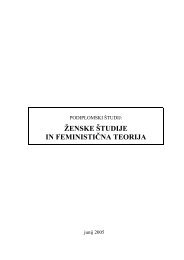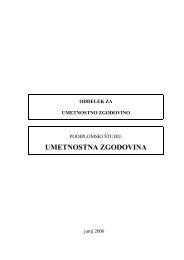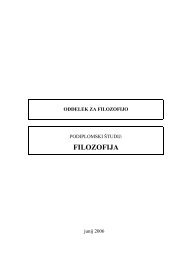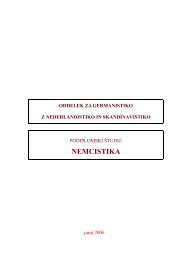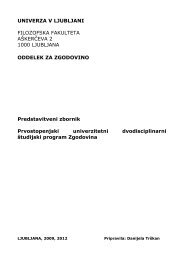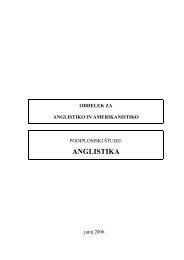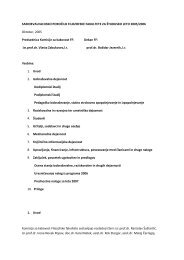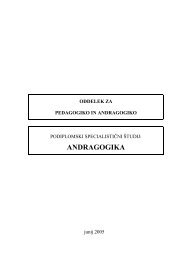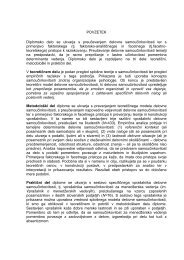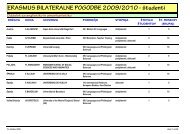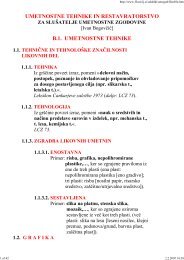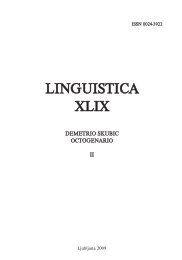B_solo_zgibanke male new_1 - Filozofska fakulteta
B_solo_zgibanke male new_1 - Filozofska fakulteta
B_solo_zgibanke male new_1 - Filozofska fakulteta
Create successful ePaper yourself
Turn your PDF publications into a flip-book with our unique Google optimized e-Paper software.
(5) French. adverbial question words ending in a nasal vowel lack liaison; for<br />
instance, quand|est-il arrivé ‘when did he arrive’ (Jereb 2004: 13). the corresponding<br />
conjunctions do have liaison; for instance, quand^il viendra ‘when he arrives’.<br />
the two variants: adverbial question words and the corresponding conjunctions. –<br />
the deduction does NOt proceed only in the unnatural environment “the initial<br />
vowel of a pronounced word” but also involves the preceding word. Consequently<br />
there is no reason for chiastic alignment.<br />
1. the assumptions of Natural Syntax:<br />
1.1. >nat (conjunction, adverb)<br />
i.e., a conjunction is more natural than an adverb. – as regards sound body, a<br />
conjunction is lighter than an adverb, and therefore more natural according to the<br />
criterion of least effort, item (b) in the list of axioms. Conjunctions as a token are<br />
more frequent than adverbs as a token, and therefore more natural according to the<br />
frequency criterion, item (d) in the list of axioms. Conjunctions as a type are less<br />
frequent than adverbs as a type, and thus conjunctions are more natural according<br />
to the criterion of small vs. large class, item (e) in the list of axioms.<br />
1.2. >nat (+,–) / liaison<br />
i.e., realized liaison is more natural than unrealized liaison. – the absence of<br />
liaison is in the interest of the hearer because it is easier for him to identify words<br />
lacking liaison. according to the criterion of favourable for the hearer, item (a) in the<br />
list of axioms.<br />
2. the rules of parallel alignment:<br />
2.1. value a tends to associate with value C,<br />
2.2. value B tends to associate with value D.<br />
3. the consequences:<br />
if a language distinguishes between adverbial question words and corresponding<br />
conjunctions such that one alternative has liaison and the other alternative lacks it,<br />
then it is conjunctions that tend to have liaison and it is adverbial question words<br />
that tend to lack liaison. Q.e.D. (the reverse situation is not expected.)<br />
(6) French. in verb forms ending in , there is liaison only with the immediately<br />
following personal pronoun. For instance, il dort|encore ‘he is still sleeping’ lacks<br />
liaison, whereas dort^-il ‘is he sleeping’ does have liaison (Léon 1966: 120).<br />
the two variants: the type dort-il and the type dors/t + other word. – the<br />
deduction does NOt proceed in the unnatural environment “the initial vowel of a<br />
pronounced word” but also involves the final segments of the preceding word.<br />
Consequently there is no reason for chiastic alignment.<br />
1. the assumptions of Natural Syntax:<br />
1.1. >nat (the type dort-il, the type dors/t + other word)<br />
i.e., the type dort-il is more natural than the type dors/t + other word. – according<br />
to the criterion of least effort, item (b) in the list of axioms.<br />
1.2. >nat (+,–) / liaison<br />
41



